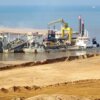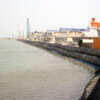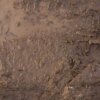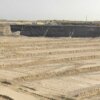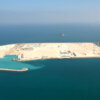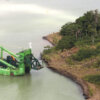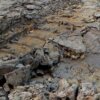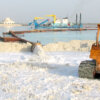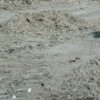Bunds are constructed to create stability of existing subsoils, slope angles and water levels to ensure the integrity of the reclamation area.
Bunds are constructed to:
- contain the fill and, sometimes, the suspended solids within the footprint of the reclamation area or settling pond;
- control the slope angle of the edge of the reclamation area;
- improve stability of fill placed on soft existing subsoil;
- control the water table within the reclamation area; and
- control the flow of the discharge water in the fill area.
Sometimes bunds are required for operational reasons:
- to support or accommodate pipelines;
- to allow access for equipment;
- to accommodate anchors;
- to compartmentalise the reclamation area; and
- allow access to the site.
Stability analyses
Stability analyses have to be undertaken to investigate the integrity of the bunds during the filling operations. These analyses may include critical slip circle calculations, the verification of the bearing capacity and horizontal equilibrium. If required, more complicated finite element analyses should be done. Should the site be located in a seismic active region, it may also be required to analyse the response of the bunds to earthquake loading.
Natural slope angles
Natural slope angles of fill after hydraulic placement are usually (very) gentle. These slopes will depend on the placement method, the particle size distribution of the fill and the exposure to waves and currents. Should the fill not be contained by bunds, large volumes of fill may be deposited outside the actual footprint of the reclamation area.
By constructing bunds and profiling their slopes to their required stable slope angle, it is possible to limit the volume of fill. In general it can be stated that with increasing coarseness of the bund material the slopes can be constructed at steeper angles.
If the subsoil of the reclamation area consists of soft material having a low shear strength, a stable bund around the perimeter of the area may help to improve the stability of the fill. This bund can be constructed on top of a sand filled trench cut down to more competent strata. This construction method can prevent the need for entire removal of the soft strata or the construction of very gentle slopes.
Bunds constructed to guide the flow of the discharge water can influence the current velocity of the discharge water within the fill area. By adjusting this velocity it is possible to control the settling regime.
Closed fill area
An area fully enclosed by bunds that reach above water is generally called a closed fill area or confined disposal facility (CDF). To allow the discharge water to drain, adjustable weir boxes are usually placed in the bunds.
Partly closed or open fill area
At a partly closed or open fill area, which lacks bunds at one or more sides, the discharge water runoff freely through the open section. If the bunds are sufficiently watertight and stable it may be possible to raise and control the water level within the contained area by adjusting the level of the overflow of the weir boxes. This may affect the settling regime of the fill and in particular of the fines. It might also be a solution to create sufficient water depth to allow for floating equipment like a spreader pontoon in the reclamation area.
Methods of bund construction
Depending on its function, its retaining height, the availability of construction materials, and other factors, a bund may be constructed of dredged or imported rock fill or quarry run, borrowed granular or cohesive fill material or just material available in the immediate vicinity of the bund. Very soft to soft clay or silt, however, is not a suitable construction material. Sometimes these materials are used for filling geotubes which may be used to bund a reclamation area.
There are many ways to construct bunds. A distinction can be made between bund construction below water level and above water level.
Bund construction above water level
Bunds may be constructed in one or more layers to their final level. In case the bund is constructed in several layers, the bund is generally raised just above the level of the next fill phase. This method may provide a better control of the final slope. Usually these bunds are compacted by bulldozers.
If the bund has to be constructed on soft subsoil, stability considerations may require a staged construction with a limited height for each lift and a gentle overall slope.
Alternatively, it may be possible to construct the bund on top of a trench excavated into the soft soils. Another solution is to increase the shear strength of the subsoil prior to or during construction of the bund by soil improvement techniques.
Bunds that will be raised in one lift from below water level to above water level can be constructed by:
- reclaiming a strip at the inner side of the reclamation area by discharging through a pipeline or rainbowing. Bulldozers, excavators or backhoe dredgers can be used to profile the outer slope to the required slope angle;
- truck dumping (‘end tipping’) and subsequent profiling with an excavator or a backhoe dredger;
- a backhoe or a grab dredger side-casting material dredged in the immediate vicinity of the bund (usually limited to relatively shallow waters).
Bund construction below water level
Bunds built below water level (offshore) in various lifts will require water-borne equipment:
- when using quarry run, originating from onshore sources, a side-stone dumping vessel, a grab hopper dredger or barge with a grab dredger can be used to construct the bunds;
- when using sand fill, a trailing suction hopper dredger can be used to raise the bunds by controlled placement through bottom doors or rainbowing (it may be required to further profile the bund afterwards). Some trailers have the capability to place sand by pumping it through their suction pipe (‘reverse pumping’). Also a grab dredge may be used or controlled placement of hydraulic fill material using a diffuser.
Once the fill has reached a level well above water level, further construction of the bunds is carried out by bulldozers and excavators. Whether the bund is immediately raised to its final height or construction is continued using more subsequent lifts depends on various factors such as:
- the geotechnical stability of the slopes;
- the management of the discharge water in the fill area;
- the soil improvement requirements; and
- other operational considerations.
To protect the bund from erosion during hydraulic filling, plastic sheeting is occasionally placed on the inner slope of the bund.



